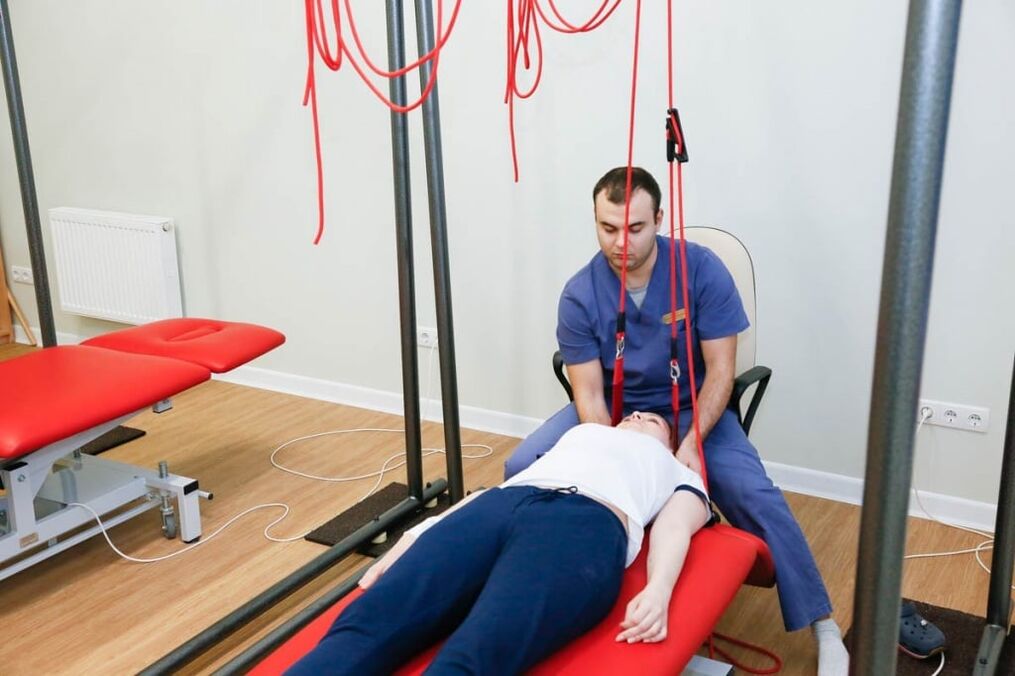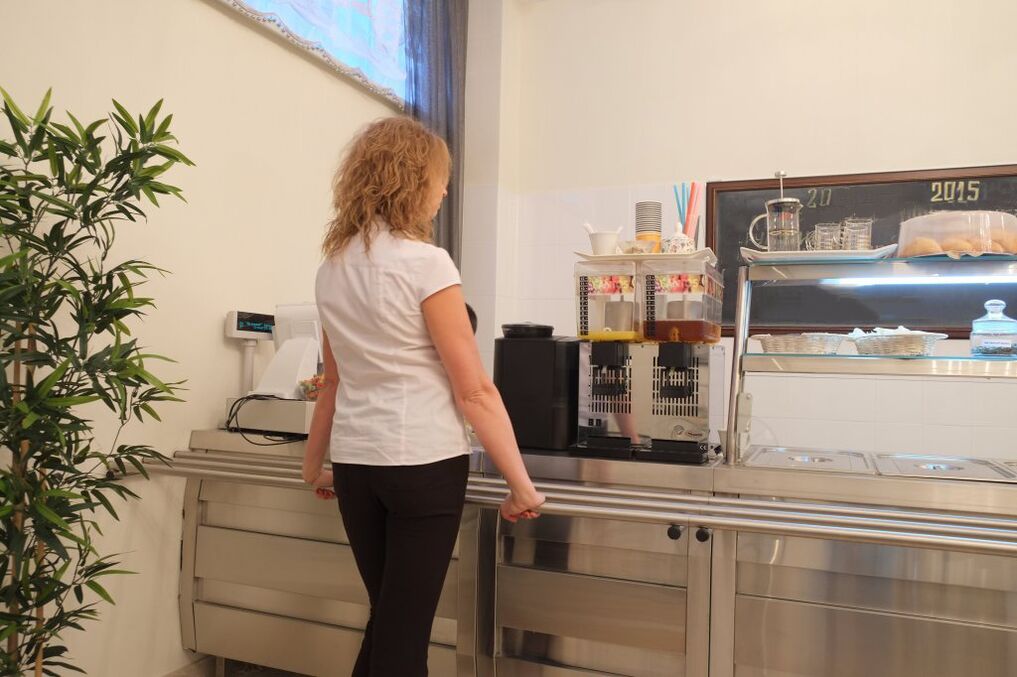Cervical osteochondrosis is a disease that affects the spine and intervertebral discs. Cervical osteochondrosis refers to deformed dorsopathies. Evolutionary changes in discs have already been observed at the age of 20. At the same time, they are more sensitive to loads, less elastic and lose lubricating fluid.
It is most common in pathological adults, but there is currently a significant increase in incidence among children and adolescents. Neurologists diagnose cervical osteochondrosis using the latest diagnostic tests. Once the diagnosis is confirmed, complex therapy with the most effective drugs, physiotherapy procedures and innovative physical rehabilitation methods is carried out.
The name of the disease consists of two Greek words "osteon" (bone) and "chondros" (cartilage). Cervical osteochondrosis begins with changes in the central part of the disc. The intervertebral disc loses moisture and shrinks in size, causing the vertebral bodies to converge and the nerve roots to become damaged. Vertebrates receive harmful nutrients from the surrounding tissues. Compression of nerves and blood vessels causes a protective muscle spasm and causes pain as the disease progresses.

Which doctor treats this disease
Treatment of osteochondrosis is the field of activity of neurologists. However, when signs of osteochondrosis of the neck appear, it is possible to consult a general practitioner. A neurologist will choose medications that are important for the treatment of cervical osteochondrosis with the least stress on the body.
The patient is sent for a thorough examination to determine the presence of a pathological process in the cartilage tissue and cervicobrachial osteochondrosis. Tactics on how to treat cervical osteochondrosis are developed based on research results.
Interdisciplinary cooperation also allows for the treatment of additional diseases experienced by the patient. In addition, the patient is provided with full information support: a treatment plan, an extract on the cost of services, specialist consultations and diagnostic measures.
Reasons
Cervical osteochondrosis develops under the influence of various stimuli. The exact cause of cervical osteochondrosis has not been determined. The disease is often associated with metabolic diseases and aging of the spine.
Researchers say that cervical osteochondrosis develops for the following reasons:
- Excessive stress on the spine. High load on the spine is observed when wearing the wrong shoes, flat feet, obesity, long sitting position;
- Metabolic diseases. Vitamin, mineral deficiency, disorders of calcium metabolism can be the cause of degenerative processes in the vertebrae;
- Congenital and acquired anomalies of the spinal cord and ligaments (thickening of the ligaments, lumbarization, sacralization);
- Pathologies of the gastrointestinal tract lead to insufficient absorption of nutrients;
- Infection, intoxication;
- Injuries, bruises, spinal fractures that disrupt the blood supply and innervation of the spine, causing dystrophic disorders in them;
- Stress;
- Wear high-heeled shoes;
- Pregnancy, especially multiple pregnancies;
- Autoimmune lesions of connective tissue, abnormal structure of collagen type 1 and 2;
- Occupational hazards (lifting heavy loads, prolonged vibration, working in a sitting position with a constant head tilt);
- Atherosclerotic and other changes in the vertebral arteries;
- Spinal curvature (kyphosis, scoliosis, kyphoscoliosis).
An important risk factor for the development of cervical osteochondrosis is hereditary. This fact proves that children have osteochondrosis when the spine is not yet overloaded.
Degrees
Thanks to the special structure of the spine, it can perform its functions. The main structural unit is the spinal motion segment (VMS). It consists of two adjacent vertebrae, an intervertebral disc and a musculoskeletal system. Osteochondrosis causes dystrophic-degenerative processes first in the intervertebral disc and then in the vertebrae. With the defeat of a vertebra, the performance of its functions is ensured by the adjacent ones. This leads to an increase in the load on the affected segment and a loss of mobility.
Doctors distinguish several stages in the development of cervical osteochondrosis:
- First degree cervical osteochondrosis. The intervertebral disc undergoes degenerative changes because it is deprived of its own blood supply and receives nutrients from the surrounding tissues. Stage 1 osteochondrosis is characterized by destruction of the pulp of the nucleus and cracks in the ring fibrosis. Clinically, this is manifested by acute or persistent local pain (cervical) and stiffness in the neck;
- Secondary osteochondrosis of the cervical spine. At this stage, the destruction of ring fibrosis continues, pathological mobility and instability of the vertebrae are visible. Patients complain of neck pain, physical exertion, bending of the head, or aggravation of a certain condition;
- The third stage of the disease is characterized by complete destruction of ring fibrosis. The gelatinous nucleus is not stabilized. Herniated discs can form and cause severe pain. At this stage, spinal curvature may occur due to poor SMS fixation;
- In the fourth stage of the disease, the intervertebral disc is replaced by connective tissue, and other adjacent segments are affected. Spondyloarthritis, arachnoiditis develops. The joints become completely immobile - ankylosis develops. Bone tissue grows around the affected area - an osteon is formed. With the fourth degree of cervical osteochondrosis, there are vivid symptoms: severe pain in the arm, sternum, the area between the shoulder blades, sensitivity disorders.

Symptoms and signs
In the early stages, the symptoms of cervical osteochondrosis may be nonspecific: dizziness, headache, weakness, wheezing during head movements. As the disease progresses, the following symptoms develop:
- Severe pain in neck and shoulders;
- Hand numbness;
- Dizziness;
- Increased blood pressure;
- Violation of coordination of movements;
- Increased sweating.
There are several syndromes that occur with the development of pathological conditions of the muscles of the back and cervical spine:
- Cervical migraine syndrome.
- Vertebral artery syndrome.
- Hypertensive syndrome.
- Heart syndrome.
- Radicular syndrome.
Occurs when nerve endings are injured and arteries and veins constrict during the development of the disease. The most dangerous complication is vertebral artery syndrome. There is a disruption of blood flow from the arteries that feed the brain and spinal cord. The patient's hearing is reduced, vision is reduced, and constant dizziness develops. The patient may lose consciousness while driving due to severe impaired blood flow.
Compression of the nerves responsible for the innervation of the chest and diaphragm muscles causes pain in the heart region, which is not associated with heart disease, but may also develop tachycardia, arrhythmia and hypotension. Vascular constriction leads to the development of hypertensive CSF syndrome. Increased intracranial pressure in the brain, nausea, vomiting and severe headaches are caused by impaired blood flow to the brain.
Radical syndrome develops as a result of neck compression - severe pain in the neck, shoulders, shoulder blades and back of the head. The arms and neck area are associated with this syndrome. A patient with cervical migraine syndrome is concerned about the severe pain in the occiput, often accompanied by nausea and vomiting.
Reflex syndromes occur when the spinal roots are not yet affected. Patients complain of pain in the neck, head (especially behind the head), arms on one or both sides. Reflex pain, unlike radicular pain, is not associated with sensory disturbances. Cervical can be dull and painful. Acute "lumbago" pain is called cervicago. There is a spasm and muscle pain, pain in the paravertebral points. Symptoms of cervical osteochondrosis are aggravated by restlessness, dizziness, cough, physical exertion. Symptoms of epicondylosis, humeroscapular periarthrosis, and shoulder-hand syndrome are caused by nerve impulses from the ring fibrosis of the affected segment, leading to compensatory muscle spasm.
Radicular syndromes are accompanied by impaired motor function and sensitivity. At the same time, as a result of the narrowing of the intervertebral canal, nerves and blood vessels are damaged, venous and lymphatic flow in the pathological focus is disturbed. In radicular syndrome, the pain is sharp and intense. A common cause of spinal nerve entrapment is the formation of a hernia. Decreased muscle tone in the pathological focus area. With radiculoischemia, the arteries constrict in addition to the nerves.
If the phrenic nerve is involved in a pathological process, heart syndrome occurs. Burning on the left side of the chest, sharp pain, radiating to the arm, interduloid region. The name of the syndrome is due to the fact that the nature of the pain is similar to angina pectoris. The main difference between pain in angina pectoris is that it can be relieved after taking nitroglycerin, can occur at rest, and is associated with interruptions in heart rhythm (tachycardia, arrhythmia).
Symptoms of cervical osteochondrosis depend on the localization of the pathological process. Damage to the upper cervical vertebrae disrupts the blood supply to the brain due to constriction of cerebral vessels. This causes headaches (especially in the occipital region), dizziness, fainting, and high blood pressure. Dizziness with cervical osteochondrosis occurs due to decreased blood flow to the inner ear. Patients are concerned about nausea, vestibular and eye symptoms.
Cervicothoracic osteochondrosis with a combined lesion of the vertebrae. The disease manifests itself with the following symptoms:
- Dizziness;
- Neck and arm pain;
- Dizziness, creeping sensation in the upper extremities;
- Intercostal neuralgia.
Diagnostics
Cervical osteochondrosis is a chronic disease that can cause hernias and spinal cord compression. Therefore, it is important to make an accurate diagnosis and start treatment in time. The following types of instrumental diagnostics are used to diagnose cervical osteochondrosis:
- Spondylography or radiography of the spine. This research method is painless, highly informed and does not require special training. Radiography of the spine allows you to assess its anatomical and functional features. The figure focuses on the structure of the vertebrae, their relationship to each other, the distance between them, the lumen of the spinal canal;
- Computed tomography - mainly provides information about the condition of bone tissue, allows you to identify the narrowing of the spinal canal and a herniated disc;
- Magnetic resonance imaging - allows you to detect changes in soft tissues. MRI images clearly show changes in the intervertebral discs and spinal cord.

Drug treatment
Treatment of cervical spine osteochondrosis consists of drug and non-drug therapy. Even after a complete treatment, neurologists take preventive measures to rule out relapses of the disease. In the acute period, for the treatment of cervical osteochondrosis, doctors prescribe drugs to patients of the following pharmacological groups:
- Non-narcotic analgesics. It is taken orally or intramuscularly to get the effect quickly;
- Non-steroidal anti-inflammatory drugs;
- B vitamins in large doses.
Diuretics are used to reduce fluid retention in the spinal cord and surrounding tissues. Antihistamines enhance the effect of analgesics. Muscle spasms are relieved with muscle relaxants. With long-term severe pain syndrome, neurologists apply a nerve block.
Chondroprotectors are used to improve metabolic processes in the intervertebral disc. These drugs increase the content of glycosaminoglycans, increase the strength, elasticity and shock absorption of intervertebral discs.
Dizziness pills
Patients with cervical osteochondrosis often experience dizziness. To reduce them, doctors prescribe non-steroidal anti-inflammatory drugs. NSAIDs belonging to different groups differ in their effect and mechanism of action, so the appropriate drug can be prescribed only by a qualified specialist.
It is important to remember that medications for cervical spine osteochondrosis cannot be taken without a doctor's prescription. Non-steroidal anti-inflammatory drugs have side effects, so before prescribing them, the neurologist determines the presence of contraindications in the patient and the appropriate dose. Medications for dizziness in cervical osteochondrosis improve the patient's quality of life.
Injections for osteochondrosis
Injections into cervical spine osteochondrosis help relieve pain during exacerbations. The effect of this drug is rapid. Neurologists use a variety of injections.
Nurses administer the drug subcutaneously, intramuscularly, or intravenously. During the exacerbation of the disease, injectable drugs with cervical osteochondrosis have an exceptionally symptomatic effect.
Headache treatment
Headache is a symptom of various disorders. However, cervical osteochondrosis is characterized by intense headache seizures. Head movements increase symptoms, so doctors prescribe analgesic tablets and non-steroidal anti-inflammatory drugs to relieve it.

Methods of drug therapy
Complex drug-free treatment of cervical osteochondrosis of the spine includes:
- Protective mode - when the roots are compressed, patients lie on a hard surface,
- Massage;
- Physiotherapy exercises;
- Spinal traction;
- Physiotherapy procedures.
Massage for cervical osteochondrosis is used to reduce pain and swelling, improve peripheral blood supply and relieve muscle spasms. Contraindications to this procedure are severe pain. Massage the neck and back in the direction of lymph flow. Special attention is paid to the occipital and paravertebral areas.
Therapeutic gymnastics for cervical lumbar osteochondrosis is aimed at relieving muscle spasms and strengthening the muscle frame. Because vertebral instability often occurs in the cervical spine, exercise therapy conducts individual lessons and teaches the patient to perform the exercises safely during this time. Some authors recommend physical therapy classes on the Shants collar.
To improve the mobility of the cervical vertebrae, rehabilitation therapists recommend the following exercises:
- Bending and stretching the neck. Without pulling your shoulders forward, turn your head forward towards your sternum, then pull back. Hold the incline for 3 seconds, repeat each exercise 8-10 times;
- The neck turns. Before changing the position of the shoulders and the level of the chin, turn your neck to the left, then to the right until it stops;
- Keep your head down until you stop. Then turn your head back without changing the level of your shoulders. Hold the position for 5 seconds.
The following exercises have been developed to strengthen the neck muscles:
- Put your hand behind your head. Lean on your hands and turn your head back;
- Put your hand on the temporary area. When bowing your head, resist with your hands;
- Put your hand on your forehead, resist, turn your head forward;
- With your right hand and your left hand, turn your head to the side behind you. Repeat the exercises on the other hand.
Autogravity therapy is the full name of the spinal traction procedure. Implemented using special devices. The goal of therapy is to reduce muscle spasms and restore the proper condition of the vertebrae. Spinal traction is performed by a doctor to prevent complications.
The following physiotherapeutic procedures are used to improve blood supply, eliminate swelling and relieve pain in the pathological focus:
- Diadynamic currents. During this procedure, low-frequency currents are applied, which stimulate the muscles and relieve spasms and pain using a special device. Have a positive effect by improving tissue trophism;
- Ultraviolet radiation. Under the influence of UV radiation, the metabolism of vitamin D improves, the amount of calcium increases, bone tissue is strengthened;
- Ultrasound exposure - used to accelerate blood flow, antispasmodic and restorative actions. Ultrasound can penetrate deep into tissues, sometimes used for better absorption of drugs;
- Amplipulse therapy - allows you to relieve pain by blocking nerve impulses from the painful focus.
In the acute period of the disease, which lasts 4-7 days, painkillers, antispasmodics, irritants are used to reduce pain. The patient is provided with peace. Cervical lumbar immobilization A shunt collar is used. Sports therapy and massage are contraindicated. Apply ultraviolet radiation.
The duration of the subacute period is 29 days. After full recovery, the patient should rest for a few days. Then you can start a course of rehabilitation therapy. In the chronic course of the disease, the patient is prescribed muscle relaxants, chondroprotectors, B vitamins, analgesics, NSAIDs. Physiotherapy exercises, massage are provided. The patient is released from physiotherapeutic procedures (amplification, exposure to alternating current), spinal traction is performed.

Eating
For osteochondrosis, proper nutrition is an important condition for achieving remission. The development of cervicothoracic osteochondrosis is stopped by diet and treatment. Neurologists know how to treat cervical spine osteochondrosis, so they organize a number of therapeutic interventions, including procedures, sports therapy, proper nutrition, and lifestyle changes.
Many patients consult a neurologist with questions about how to treat cervical osteochondrosis and whether there are dietary restrictions. Specialists create individual nutrition programs that take into account the patient's preferences. The diet for osteochondrosis is based on a rich, balanced, low-fat diet. The patient's daily diet contains foods rich in calcium.
How to sleep with cervical osteochondrosis
For patients with diseases of the musculoskeletal system, the question of how to sleep properly with cervical osteochondrosis is relevant. Sleeping on your stomach can make the disease worse, so it's best to avoid sleeping in this position. The optimal positions are at the back and side.
Cervical osteochondrosis progresses when resting on a soft mattress. Therefore, experts advise to prefer elastic mattresses and moderately soft pillows. If a patient is diagnosed with cervicothoracic osteochondrosis, experienced specialists will tell you which bedding is safe to sleep on.
Prophylaxis
To prevent the onset or development of cervical osteochondrosis, doctors recommend:
- Maintain proper posture;
- Lead an active lifestyle, take breaks from work;
- Exercise physiotherapy regularly;
- Sleep on a firm and flat surface, orthopedic mattress and pillow;
- Get rid of bad habits, especially smoking;
- Choose shoes taking into account the physiological structure of the foot;
- Do not carry bags on one side, as this will cause the spine to bend;
- Maintain a healthy lifestyle, eat right, eat lots of fruits and vegetables;
- He does not sit for a long time bowing his head;
- Go swimming.
Massage therapy should be performed regularly to improve blood circulation.






























